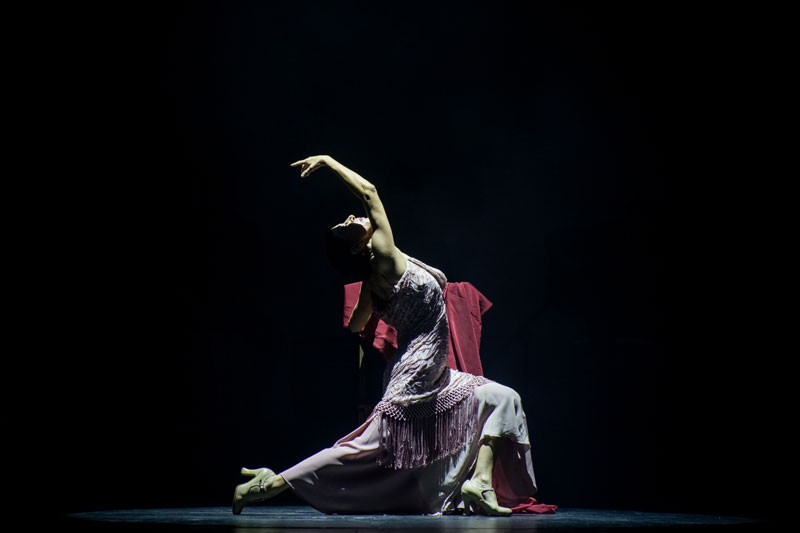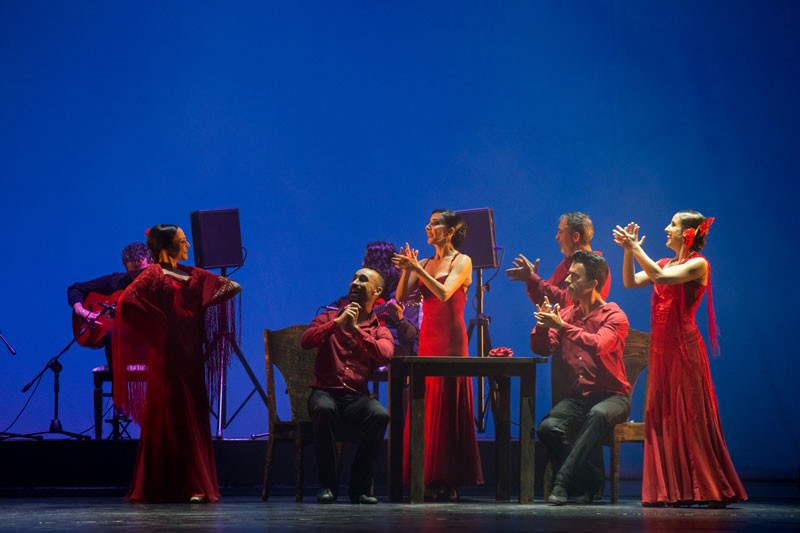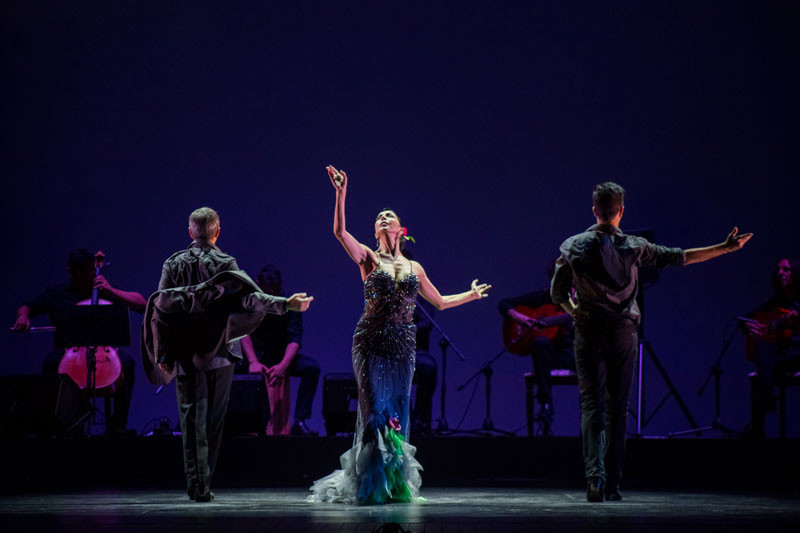Passion and tension are obligatory ingredients that charge any viewer with expression. Wherever they are from. Whatever language they speak. After all, flamenco is perceived by skin. Still no one was left indifferent by the rapping of dancer's heels and painful singer's roulade.
______________________
Flyura Musina
ballet critic
One of important tasks of the festival is acquaintance of audience with culture of different countries. And, as is known, people’s soul is best manifested in dance. So flamenco became a kind of symbol of Spain, its trademark. Castro Romero Flamenco team represented this art on the stage of "Astana Ballet", the founders and leaders of which are sister and two brothers Castro Romero - Rosario, Ricardo and Jose. The artists, whose schedule was planned for a year ahead, flew to Astana with the European Music Open Festival, where, just a few days ago, they showed their art on June 22. And on June 10th they were in Moscow, as they are permanent participants of the opera "Carmen", the choreographic scene put by Ricardo. The team has existed for 30 years, during this time a huge number of projects have been made, including participation in the filming of films ("Sorceress Love" by Carlos Saura), performances with famous artists (such as Farukh Ruzimatov), participation in concerts with world opera stars (for example - Montserrat Caballe, Placido Domingo and Jose Carreras), performances all over the world, teaching flamenco, etc.
In general, there was an impression that mobility is the main quality of entire family of Castro Romero, otherwise it is simply impossible to have as much time as those smiling, open to the world and some very energetic people manage to do. Perhaps it is the spirit of flamenco - duende, nourishes their energy?
So the interview had to be taken in the process - during a ten-minute pause in rehearsals, or during the imposition of makeup.

F.M. - Rosario, your team is doing so many different projects, which one is the most important for you, are you especially proud with?
Rosario Castro: The most important is the one we are in at the moment. And now for us the most important thing is what we will show here, at this remarkable festival "Eurasian Dance Festival". We brought the program "Flamenco Quintessence" in 10 parts of which we try to tell about what flamenco and its soul - "duende" – is. This word is also translated from Spanish as "fire", "magic" or "feeling."

F.M. – Is it long time to master this magic? At what age does the schooling for flamenco begin?
Rosario Castro: Usually since eight, because flamenco is already an established art with its canons and a variety of trends and styles. There are two stylistically and musically distinct flamenco classes: the oldest, the tallest - it is called cante hondo and the modern, lightweight -cante chico. Within both classes of flamenco there are more than 50 genres, the exact boundary between which is sometimes difficult to conduct. Therefore, it is not easy to master the secrets of flamenco.
F.M. - When did you start studying this difficult art?
Rosario Castro: Officially, I started dancing late at the age of 16. And my brothers too. But we were born in an artistic family, my mother Caro Romero was a flamenco performer and teacher, and my father was a musician. Our childhood passed in constant tours, so we could not study constantly in the same school, but we passed our mother's flamenco school, and it was as natural as breathing and playing. And later, in 1984, I decided to start my company with my brothers. Since then we are also in constant tours, we are roaming, like gypsies!
Indeed, there is an opinion that this dance fell on the blessed land of Spain through gypsies, who fled from India from the conqueror of Tamerlane. In Andalusia the Spaniards greeted the fugitives in a friendly way and, in the process of life, Arab and Christian tunes, passion and ardor of the proud Spaniards were added to the dance, resulting in a modified and richer dance, full of strength and restrained passion.
Flexible arms and body and tense, strong legs, shot imprinting heels on the floor, a moment of immobility, a sharp turn - that's the flamenco magic.

And what is behind this magic - I saw behind the scenes, before the performance. Ricardo, the eldest of the brothers, standing in a corner on a special wooden stand (reminiscent of a pad, a drumming device for drummers) under the speedy sound of metronome, methodically and accurately typed his heels into a 40-centimeter pad for half an hour, sweat streamed down his neck, the dancer's face focused and exalted, as if he was doing daily prayer ... To disturb him with questions at this moment seemed just blasphemy. It was necessary to seize the moment when the artist was impregnated with makeup, and he told about himself and about the team calmly and with pleasure.

Ricardo is the oldest in age and position in this family theater of flamenco. And although the artists claim that everything is decided collegially, the last word is still behind him, he puts dances most often. He is proud to have worked with Antonio Hades, performed productions for Farukh Ruzimatov and danced with other members of his troupe, he was a soloist in the Spanish Ballet of Mariemm and the Spanish National Ballet, but gives most of his strength and soul to the “Spanish Suite” family team, although the composition has long gone beyond the family.
F.M. What is the composition of “Spanish Suite”?
Ricardo Castro Romero: "Only six dancers came to Astana, it is connected with the program, but the collective is much larger. In addition, we brought our sound engineer - sound quality is very important for flamenco, because music and singing, like dancing - are the main components, musicians play and sing "live", each time improvising. As we present the show, the light is very important, and our specialist is responsible for this part, too. "Astana Ballet", where we perform, has excellent technical equipment and highly professional, very responsive staff. Preparation for performance was at the highest level! We even made a special table in decorative workshops of the theater, on which I will perform my solo."

José Castro Romero's younger brother was short-spoken and mysteriously handsome, like a Spanish grandee. It is not surprising, since in his spare time from Flamenco, the dancer appeared on the catwalks of Paris and London more than once, worked as a model for Jean-Paul Gaultier, had a contract with Moschino, was the face of Blue Dog. On the question of how long it is possible to dance flamenco, whether there are restrictions on age, as, for example, in classical dance, Jose replied:
"An artist should not tell his age. Age is a state of mind. Someone in twenty is boring and passive, and someone in forty is full of energy"
"Flamenco is a dance genre, which age is suitable to. It is best for flamenco dancers to do exactly that "with a biography" - by forty, by fifty years old, when personal hardship, apparently, grow into artistic weight " Petersburg dancer critic Yulia Yakovleva, who often met with Castro Romero’s work confirms this statement.
And you can fully agree with this, looking at gray Ricardo knocking out the bewitching solo on the table shot; or Rosary’s flexible hands and Jose’s sharpened profile, it is even embarrassing to ask them about age. And at the same time, a thought is involuntarily appeared - how beautiful were the dancers in the prime of life, when the body is flexible and responsive to any impulse of soul? Or maybe at that beautiful time their dance was not so full of meaning? And maybe, no need to compare, because the artist fills the flamenco dance with another duendo at each age? As the connoisseurs of flamenco say: "Only one duendo is incapable - repeating. Duende does not repeat itself as the appearance of a stormy sea."

And Ricardo said even easier: flamenco is your life path ...